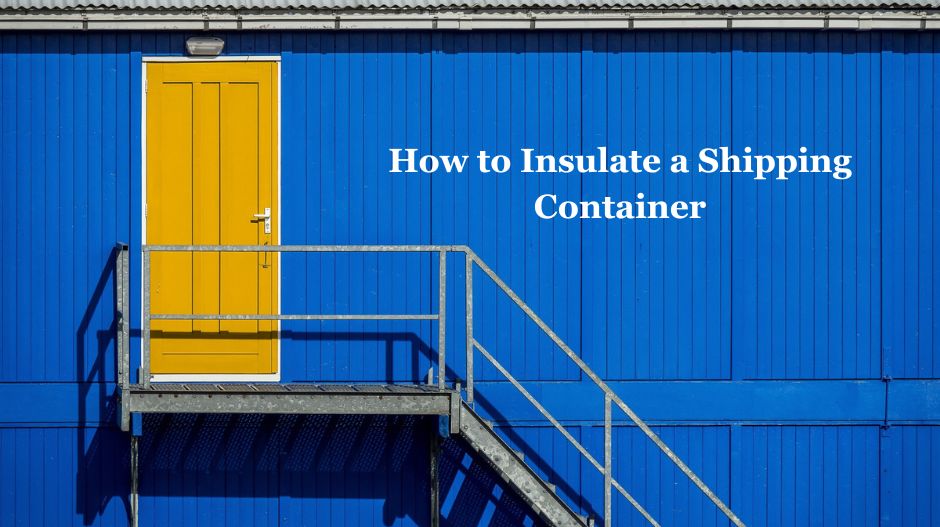Introduction

It is necessary to properly insulate a shipping container to ensure the desired temperature is maintained within the premises; whether for storage, work, or living. Proper insulation eliminates the problem of excessive heat in summer and cold in winter; in other words, it makes the container energy-efficient and liveable throughout the year. The following guide will outline why the container should be insulated, which materials are most suitable, and how to do the insulation work.
Why Insulation is Important for Shipping Containers
Containers are built to carry heavy weights but not for the purpose of temperature control. Without insulation, a container can get extremely hot during summer and very cold during winter.
Control the temperature inside to a level that is comfortable for the occupants.
Avoid condensation as this is a source of rust and structural failure.
Save money on energy if you are heating/cooling the interior space.
If there are items that are sensitive to temperature changes inside, protect them from such changes.
Insulation helps turn a shipping container into a multi-purpose building with applications for accommodation, offices, and other purposes. If you’re planning to buy a container for such purposes you can consider used shipping container dealers in Chennai or container shop manufacturers in Chennai.
Types of Insulation Materials
Spray Foam Insulation
Spray foam insulation is the best option because it offers an excellent level of thermal resistance and fills in all the cracks. It creates an airtight seal and can be directly applied on the interior walls, ceiling and floors of the container. Spray foam also prevents condensation from getting into your house and causing damage. It is not as cheap as some of the other products but it is highly efficient and easy to apply, making it a good long term choice.
Rigid Foam Board Insulation
Rigid foam boards are also another alternative for insulating shipping containers. These include boards made of such materials as polystyrene, polyisocyanurate, or polyurethane, which have high thermal resistance. And they are easy to cut and shape to fit the walls and ceiling of the container. Rigid foam boards are cheap and offer a decent combination of insulation and water resistance. Nevertheless, they are very effective but need proper fitting and sealing.
Fiberglass Insulation
Fiberglass insulation is one of the classical and economical methods. It contains tiny glass threads and is used in framed walls between studs. On the other hand, it offers decent insulating capacity but must be kept from getting wet to avoid the risk of mold growth. Since fiberglass insulation will irritate the skin, it must be handled with great care and should be installed together with a vapor barrier.
How to Insulate a Shipping Container:
Preparing the Container
First of all, it is significant to prepare the container for the insulation. This includes cleaning the interior to get rid of any dust or rust particles. Check the container for any damages and leaks on the structure and fix them. It is important to prepare the substrate in order for the insulation to bond well and function to its full potential.
Applying Spray Foam Insulation
1.Make sure that the container is well-ventilated and have protective clothes on.
2.With a spray foam kit, follow the manufacturer’s instructions.
3.Apply the foam rather equally on all the walls, ceiling, and floor especially on all the crevices and joints.
4.Leave the foam to expand and set for several hours until it becomes completely dry.
5.Cut off any unnecessary foam to achieve the desired shape.
Installing Rigid Foam Board
1.Cut the foam boards according to the inside dimensions of the container.
2.Glue the boards on the back side and stick them on the walls and ceiling.
3.Cover all joints and edges with foil tape to make them airtight.
4.Add a ½” sheet of plywood over the foam boards for added protection and strength.
Using Fiberglass Insulation
To install fiberglass insulation:
1.Install metal or wood studs to frame the interior walls of the container.
2.Cut the fiberglass batts to fit in snugly between the studs.
3.Insert the batts into the framing and do not compress the batts.
4.Seal the insulation with a vapor barrier to prevent moisture from entering.
5.End the insulation by walling the area with drywall or paneling.
Some Additional Tips for Insulation:
Sealing Gaps and Cracks
All gaps, cracks, and seams in the building should be sealed with caulk or spray foam to prevent air from escaping.
Adding a Vapor Barrier
It is important to use a vapor barrier when using fiberglass insulation. It serves to keep moisture from seeping into the insulation and causing damage or mold.
Ventilation Considerations
Ventilation is essential for the air quality and avoiding any condensation. Ventilation may be in the form of vents or an HVAC system to control air inside the container.
Conclusion
Insulating a Shipping Container from Heat and Cold is vital for making an energy-efficient. Make sure that you select the right insulation materials and use the right installation processes so that you can have a container that will not be vulnerable to temperature fluctuations. A properly insulated structure is useful for storing goods as well as a workspace or living area in a shipping container. Those in Chennai may then start searching options offered by used shipping container dealers in Chennai or container shop manufacturers in Chennai for the right container. For those who require insulated storage container in Chennai, here are some good places to look.
